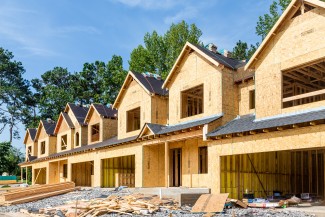Groups Call on HUD, USDA, VA to Update Standards to Cut Costs and Carbon Emissions, Create Jobs
Washington, DC—Hundreds of thousands of new homes purchased each year with federally backed loans and programs are built to outdated energy efficiency standards, saddling low- and moderate-income households with needless energy costs and raising greenhouse gas emissions, according to a new analysis released today. Other new homes backed by Fannie Mae and Freddie Mac have no limit on energy waste. The American Council for an Energy-Efficient Economy (ACEEE) found that if regulators regularly update efficiency requirements for the homes, they can create one million job-years of work, reduce total costs by $29 billion, and avert carbon pollution equivalent to that from 67 million passenger vehicles in a year.
In a letter dated Thursday, 18 energy efficiency organizations and associations called on Housing and Urban Development (HUD) Secretary Marcia Fudge and Department of Agriculture (USDA) Secretary Tom Vilsack to move quickly to update the standards to ensure new homes are far more energy efficient.
“It just doesn’t make sense for the government to be funding new houses that are inefficient and come with higher energy costs, while causing more emissions,” said Steven Nadel, executive director of ACEEE. “Congress required that these homes be efficient, but the regulators haven’t kept up. We could see a big win for the climate if HUD and USDA follow the law and get these criteria updated to today’s best practices.”
Updating the standards to match new model codes would ensure that the new homes have more insulation, are less drafty, have better lighting, and perhaps have far more efficient water heaters or use heat pumps. ACEEE found that homes built each year to outdated criteria will cost owners and renters an extra $1.1 billion, emit 6 million metric tons of unnecessary CO2, and reduce employment by 18,000 job-years.
Congress directed regulators to periodically update standards for new homes purchased with the support of federally backed mortgages and federal housing programs to ensure that they do not burden residents with high energy costs. The requirements, included in bipartisan legislation passed in 1992 and revised in 2007, cover new homes purchased with loans guaranteed by the Federal Housing Administration (FHA), USDA loans, and HUD housing programs; there also is a requirement for Department of Veterans Affairs (VA) loans. These loans and programs are primarily designed for low- and moderate-income borrowers and renters, and together they cover roughly 18% of new single-family homes and multifamily units, or 228,000 homes each year. The current efficiency criteria for most of the homes at issue, set in 2015, are based on model building codes from 2009 and 2007.
The law requires the agencies to update the criteria to the newest model building codes upon a determination that doing so would not negatively affect the availability or affordability of covered housing. ACEEE’s new analysis—based in part on federal data—provides answers. It finds that moving to the new code would yield net positive cash flow (the energy bill savings minus the added monthly mortgage payments will pay back the initial expense of a 10% down payment) in 17 months for an average single-family home and 26 months for multifamily building units.
The administration’s first regulatory agenda, issued this month to list pending and upcoming rulemakings, did not include the needed HUD and USDA determination, but HUD has indicated the process has started.
The ACEEE analysis finds an even larger opportunity in potential efficiency requirements for the nearly 50% of new home mortgages purchased by Fannie Mae or Freddie Mac. These “government-sponsored enterprises” (GSEs) are supervised by the Federal Housing Finance Agency (FHFA), an independent agency. Guided by FHFA and by their “duty to serve” low- and moderate-income borrowers and renters, Fannie Mae and Freddie Mac set requirements for homes covered by these mortgages, but not currently energy criteria. If FHFA or the GSEs require these homes to meet up-to-date energy codes, the benefits in terms of financial savings and emissions reductions will more than triple.



